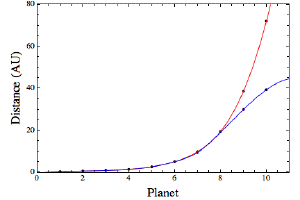Post
Pattern Recognition
23 November 2012
Astrophysics often follows a pattern of gathering lots of data and then developing models to explain the data. Groundbreaking ideas such as Newton’s law of gravity or Einstein’s theory of relativity are rare, so often we’re reduced to trying to find patterns in the data that may (or may not) have a clear cause. Sometimes this method works quite well. Perhaps the most famous one is Kepler’s laws of planetary motion. When Kepler proposed his laws, they were presented as a clear and simple description of what actually happens. They were a breakthrough because they could be used to predict the motion of planets with great accuracy.
Despite their accuracy, Kepler’s laws were simply a concise description of an observed pattern. Kepler gave no underlying physical principle to explain why his laws worked. The underlying principle was only later discovered by Newton, who was able to derive Kepler’s laws from his law of gravity.
Looking for patterns in data is useful because such patterns are often caused by a simple underlying principle, but this isn’t always the case. As an example, consider the story of the the Titus-Bode law. This law was first noted by Bode in 1772, and stated that the distance of planets followed a pattern of d = 4 + n, where n was 3, 6, 12, 24, etc. Like Kepler’s laws, it was originally stated as an observed pattern, with no clear reason as to why it worked.
 BK
BKIf you let the Earth’s distance be 10, then Bode’s law matched the distances of the (then) known planets to within a couple percent, with one exception. Bode’s law predicted a planet between Mars and Jupiter that didn’t exist. In 1781 Uranus was discovered, and agreed with Bode’s law to with a couple percent, so there began a search for the missing “fifth planet” between Mars and Jupiter. In 1801 the minor planet Ceres was discovered, and was at exactly the distance Bode predicted. It would seem that Bode’s law was a valid model, despite its lack of an underlying cause.
Two things eventually killed Bode’s law. The first was the discovery of other “planets” (now known as asteroids) between Mars and Jupiter which did not follow the law, and the second was the discovery of Neptune in 1846, which wildly disagreed with the law. Of course now we know our solar system is far more complex than Bode’s law implies. We also know of a few other stars with planetary systems, and they don’t seem to follow similar rules very well.
Still, the Titus-Bode law works really well for most of the planets in our system. I’ve plotted the law in red in the figure above, and when you compare it to observed distances (in blue) you can see how well it works up until Neptune. Such a strong agreement would seem to imply that there must be some underlying cause. It’s hard to make a compelling argument with only a handful of known solar systems, but computer models suggest that the pattern is driven by resonances between orbital periods. For example, Earth and Mars have a ratio of 1 to 2, while Venus and Mars have a ratio of 1 to 3. Such ratios are common for planets, asteroids and moons, because they tend to reinforce the stability of orbits. When these ratios are common in a planetary system (as they are in ours), a Titus-Bode law can be found for the distances.
In modern times the Titus-Bode relation is seen more as an interesting pattern than a true law. As we discover more planetary systems the relation may rise to prominence once again, but for now it’s an interesting cautionary tale that we should never limit our understanding to patterns alone.